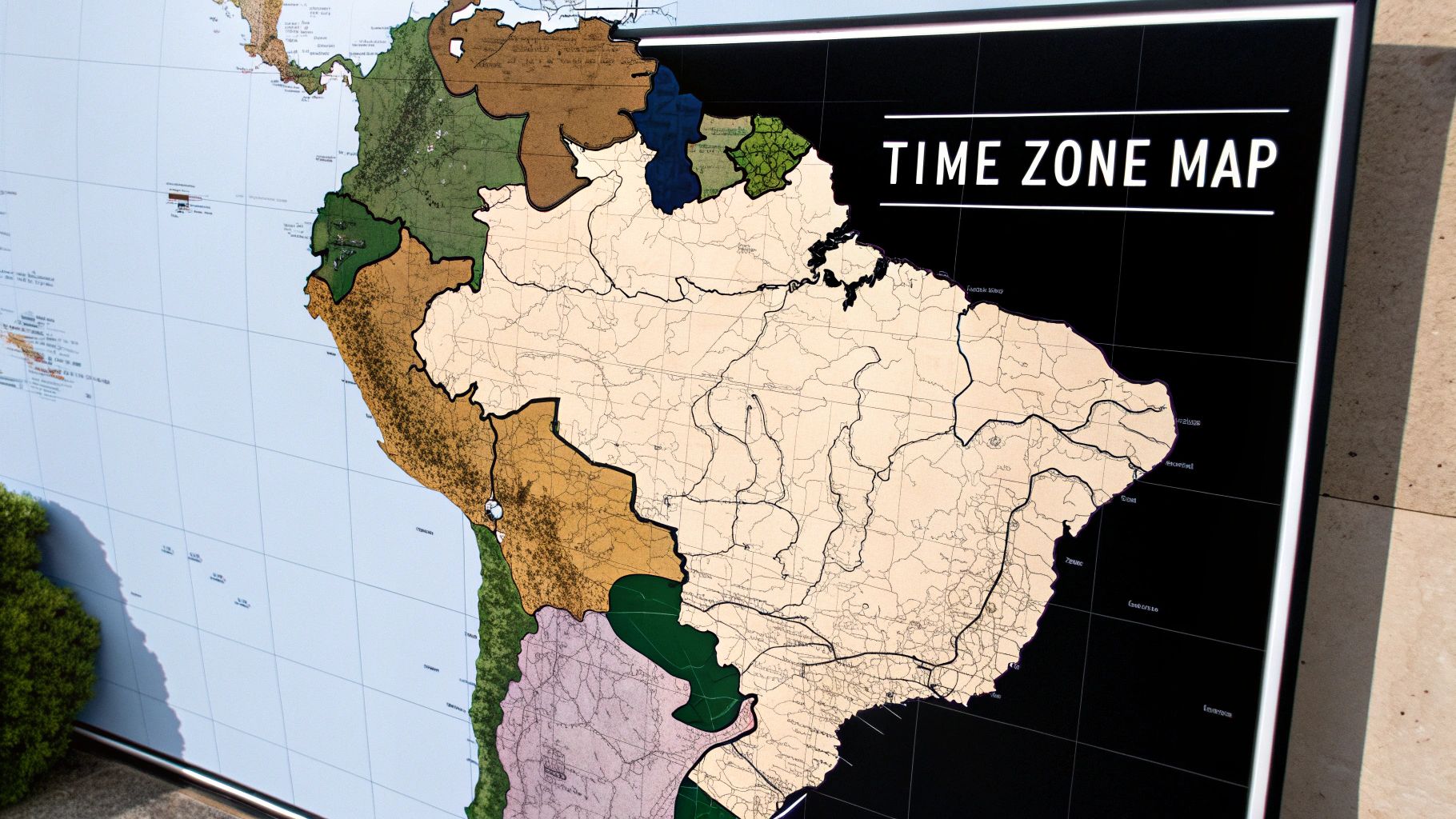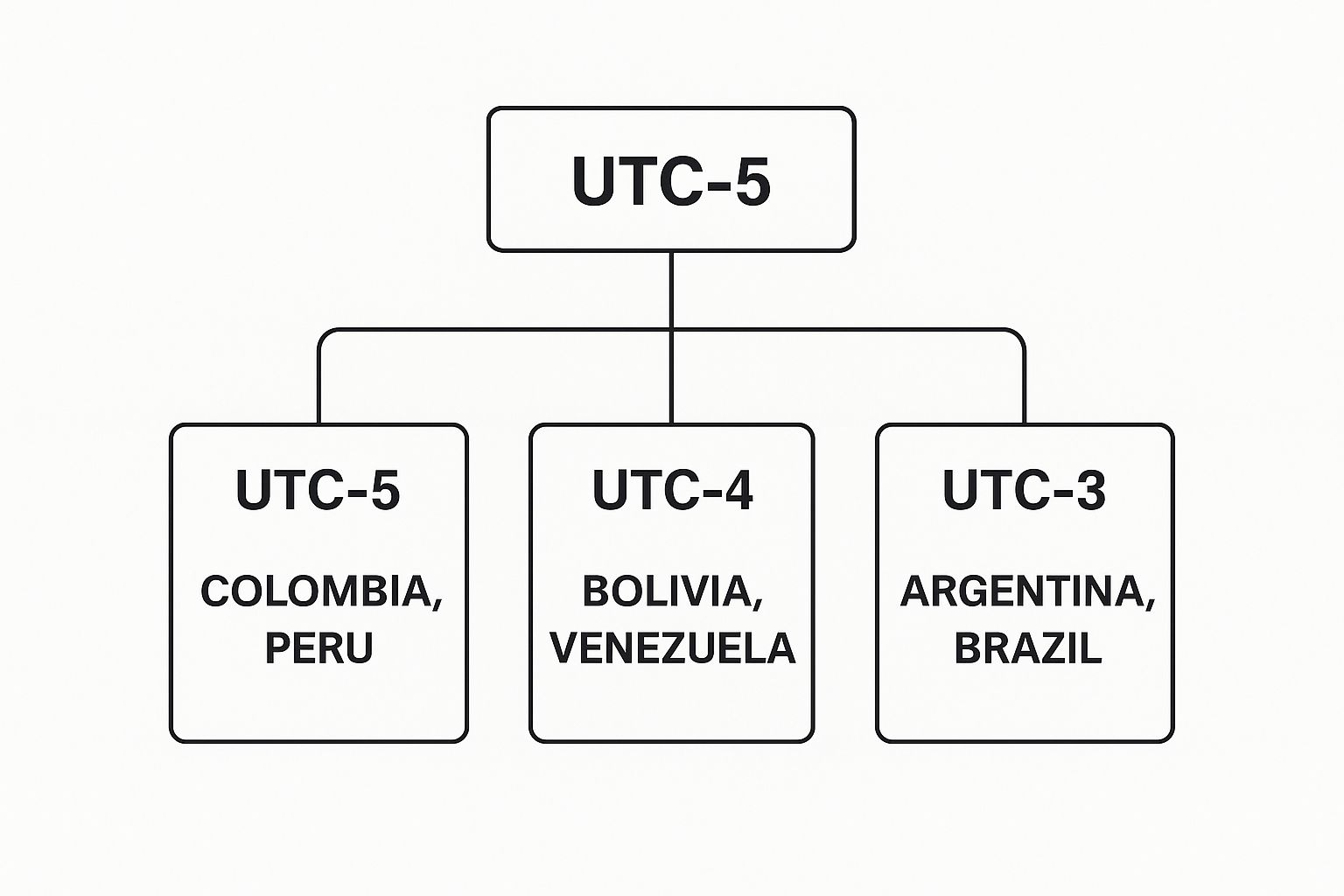A Guide to Time Zones in South America
- Ron Smith

- Sep 10
- 13 min read
Ever struggled to get a quick answer from your offshore team, only to be stuck in a 24-hour email loop? The fix might be simpler than you think, and it’s not about finding a new project management tool. It’s about geography.
Understanding the time zones in South America isn't just a trivial pursuit—it's the key to real-time collaboration that feels less like you're working across continents and more like your team is just down the hall.
Why South American Time Zones Are a Business Superpower
In a world where work is global and contingent labor is a key part of modern workforce management, the biggest bottleneck isn't distance; it's time. We’ve all been there: late-night meetings and maddening email delays because your partners are a world away. When a team in Asia is clocking out, your US-based crew is just pouring their morning coffee. That gap kills momentum and makes building a cohesive team feel impossible.
This is exactly where South America flips the script. The continent’s time zones aren’t just a convenient perk; they’re a massive strategic advantage for any company that needs to move fast. It's a foundational element of a new kind of staff augmentation that leverages global talent at an affordable cost.
Imagine crushing a critical bug or green-lighting a major decision in minutes over a quick video call, not waiting days for an email reply. That’s what happens when your workdays actually line up. It’s how you build a real culture, not just a distributed workforce.
The Advantage of Overlapping Workdays
The real magic is in the massive overlap with North American business hours. This isn't just about convenience; it's about eliminating the operational drag that grinds so many global teams to a halt.
Solve problems now, not tomorrow. Urgent issues get handled as they pop up, without that sinking feeling of waiting for another part of the world to wake up.
Build a real team. When people can actually talk and work together all day, you get real bonds and a unified culture, not just a collection of freelancers.
Move faster. Period. You can react to market shifts, customer needs, and project pivots with a team that’s on your clock.
This time zone alignment is the foundation of a smarter way to scale your team. South America spans a handful of time zones, mostly between UTC-5 and UTC-3.
Countries like Colombia and Peru, for example, run on UTC-5, which syncs up perfectly with US Central Time for most of the year. Meanwhile, economic powerhouses in Brazil and Argentina use UTC-3, putting them just an hour or two ahead of the US East Coast. It’s a game-changer.
To give you a clearer picture, here’s a quick rundown of the standard time zones across the continent.
South American Time Zones at a Glance
This table gives you a quick reference for the standard UTC offsets of major South American countries and a heads-up on which ones deal with the complexities of Daylight Saving Time (DST).
Country | Standard Time Zone (UTC) | Observes DST |
|---|---|---|
Argentina | UTC-3 | No |
Bolivia | UTC-4 | No |
Brazil | UTC-2 to UTC-5 | No |
Chile | UTC-4 (mainland) | Yes |
Colombia | UTC-5 | No |
Ecuador | UTC-5 | No |
Paraguay | UTC-4 | Yes |
Peru | UTC-5 | No |
Uruguay | UTC-3 | No |
Venezuela | UTC-4 | No |
As you can see, most countries have thankfully ditched the DST shuffle, making scheduling even more predictable. For the few that do observe it, like Chile and Paraguay, you’ll just need to keep their seasonal shifts in mind.
You can dive deeper into how South American time zones create business opportunities on nearshorebusinessolutions.com. When you pair this incredible time zone advantage with a pool of elite global talent, you get a cost-effective way to build a world-class team that’s ready to work when you are.
The Real Cost of Time Zone Misalignment

We’ve all been there. That 2 AM meeting invite that makes you wince. The email chain that drags on for days over a simple question. This isn't just an annoyance; it’s a hidden tax on your team’s momentum, creativity, and sanity.
Time zone friction quietly drains the life out of your projects.
When your development partners are 12 hours ahead, your entire day is spent waiting. You find a critical bug first thing in the morning, but by the time you can get an answer, your team is logging off. What could have been a quick fix just turned into a 24-hour delay. That constant stop-start rhythm kills agility and creates a chasm no project management tool can fix.
Now, imagine collaborating with a team just a few hours apart in South America. The flow is completely different. An urgent issue gets solved in minutes on a quick video call, not over days of back-and-forth messages. That real-time connection is what builds strong, cohesive teams that can actually solve problems together.
The Tangible Benefits of Synchronized Clocks
Working within a few hours of each other creates a shared rhythm. It fosters a truly unified work culture, not a fragmented one where teams feel like they’re operating on different planets. This synchronization delivers clear, measurable wins that go way beyond just making scheduling easier.
Solve Problems Faster: When you can actually talk to someone, you can identify, debate, and resolve complex issues in a single afternoon. No more waiting until tomorrow for a reply.
Build Real Team Bonds: Colleagues who share a workday build actual rapport and trust. Those are the cornerstones of any high-performing team.
Create a Shared Culture: Spontaneous chats and quick check-ins are possible again. This is how remote members stop feeling remote and truly integrate into the company culture.
Misaligned time zones don't just delay projects; they create a communication lag that erodes trust and cohesion. The ability to collaborate in real-time is the foundation of a truly integrated and agile global team.
How Technology Bridges the Remaining Gaps
Even with favorable time zones, you still need the right tools to manage a global workforce. The new frontier here is AI-powered platforms that can optimize scheduling and pinpoint the best windows for collaboration. These emerging trends in workforce management tech learn individual work patterns and project deadlines to make sure everyone is connected when it counts.
This is a core part of the smarter, more cost-effective staff augmentation model we provide. We combine the huge geographic advantage of South American time zones with intelligent tech to connect you with elite global talent—without the usual headaches.
Understanding these dynamics is critical. That’s why we’ve broken down how to succeed when navigating outsourcing software development risks and building a global team that’s truly built to last.
A Practical Guide to South American Time Zones
Let's be honest, figuring out the different time zones in South America can feel like a headache. But for anyone building a global team, it's not just about scheduling meetings. It's about creating a seamless, productive workflow that feels local, even when you're thousands of miles apart.
Think of this section as your playbook. We’re going to cut through the noise and group countries by their core time zones, giving you a practical map for managing projects and hitting deadlines across the continent. This is the real-world insight you need to lead a distributed team that just works.
This infographic gives you a bird's-eye view, grouping countries by their primary time zones for a quick scheduling reference.

You can instantly see the continent's major time corridors and spot the strategic alignment between key talent hubs.
The UTC-5 Western Corridor
Countries like Colombia, Peru, and Ecuador all operate on UTC-5, and they stick to it year-round. This is a massive win for North American companies because it aligns perfectly with US Central Time (CST) and sits just one hour behind Eastern Time (EST).
Colombia: A powerhouse for tech and creative talent, Colombia offers a huge talent pool that works in lockstep with US business hours.
Peru: With its booming software development scene, Peru gives you a consistent, reliable time overlap for daily stand-ups and real-time collaboration.
Ecuador: Just like its neighbors, Ecuador’s commitment to UTC-5 means no Daylight Saving Time chaos. Planning is beautifully predictable.
For any business using contingent labor, this corridor is the sweet spot. It allows for a full day of frictionless collaboration without forcing anyone to work awkward hours, which is exactly how you build a healthy, integrated team culture.
The Central UTC-4 Zone
As you move east, you hit the UTC-4 block, which includes Bolivia, Paraguay, and Venezuela. This zone is still well within North American working hours, typically running one to two hours ahead of the US East Coast.
While Bolivia holds steady at UTC-4, Paraguay is one to watch—it observes DST, so its clocks shift seasonally. Venezuela is an interesting case; it now operates on a standard UTC-4 offset, which simplifies what used to be a tricky half-hour difference.
This central zone is a perfect example of why local knowledge is king. The general time offset is great, but a nuance like DST in Paraguay requires active management—something modern workforce platforms are getting really good at handling.
The Economic Powerhouses of UTC-3
The UTC-3 zone is where you'll find South America's biggest economies, including most of Brazil, Argentina, and Uruguay. This region is a goldmine for top-tier engineering and business talent.
Being two to three hours ahead of EST gives your South American team a strategic "head start" on the business day. They can jump on overnight issues and have updates ready before their US-based colleagues have even had their first coffee.
It’s no surprise that time zones directly impact economic flow, especially with the US and Europe. For example, countries on UTC-3 like Brazil and Argentina share a solid 2 to 3 hours of overlapping business hours with the US East Coast. Brazil’s massive economy, which accounts for over 40% of the continent's GDP, spans multiple time zones itself.
For a deeper dive, this external resource offers A clear guide to time zones in South America.
Ah, Daylight Saving Time. The twice-a-year calendar chaos that makes every international team manager quietly sigh. But when you look at time zones in South America, something refreshing is happening: most of the continent has ditched it.

For any business running a global team, predictability is everything. That bi-annual scramble to adjust meeting times, check software settings, and make sure nobody misses a critical sync-up? It's friction. It’s a recurring headache that opens the door to missed deadlines and confused teams.
But a huge chunk of South America has stepped off that rollercoaster for good.
Why Stability Is the New Standard
Economic powerhouses like Brazil and Argentina have completely abandoned DST. They've chosen the stability of a single, year-round standard time, and it’s not just for kicks. It’s a smart move to simplify trade and cut the operational red tape for international businesses.
They’re not alone. In the last decade, roughly 70% of South American countries have dropped the practice altogether. The consensus is clear: the tiny benefits just aren't worth the hassle and public pushback.
This creates an incredibly stable and predictable environment for remote collaboration. When you hire talent in places like Brazil, Argentina, or Colombia, you’re not just getting their skills—you're getting a rock-solid, consistent schedule. No more guessing games. No more calendar alerts a week before the clocks change.
For a Head of Talent or an Engineering Manager, this is a hidden superpower. It means fewer missed meetings, cleaner project roadmaps, and a team that stays in rhythm without constant adjustments.
The Few Outliers
Of course, it’s not a clean sweep. A couple of countries still cling to the seasonal time shift, and you’ll want to keep them on your radar.
Chile: This is probably the most complex one. Chile typically jumps forward to UTC-3 in their spring (around September) and falls back to UTC-4 in their autumn (around April).
Paraguay: Following a similar pattern, Paraguay also observes DST, usually making the switch between October and March.
These exceptions are a perfect reminder of why sharp communication is non-negotiable for remote teams. A one-hour difference, if missed, can throw a whole day's workflow out of sync. Getting these details right is a core part of great leadership, and you can dig deeper in our essential guide to cross-cultural communication in the workplace.
Bottom line? South America’s widespread rejection of DST makes it a uniquely stable partner for nearshore teams. It’s one less variable you have to manage, freeing you up to focus on what actually matters: building great things with incredible people.
How Railroads and Politics Forced a Change of Time
Ever wonder why South America's time zones look like a patchwork quilt? It wasn't always this way. Before standardized clocks, time was a purely local thing. Each town set its clocks by the sun—noon was simply whenever the sun was highest in the sky. For most of history, that worked just fine.
Then came the railroad, and everything changed.
Imagine trying to run a train schedule when the time in one town is 15 minutes different from the next one down the tracks. It was a recipe for chaos. Missed connections, delayed cargo, and even dangerous accidents became the norm. This wasn't just an inconvenience; it was a massive brake on economic progress.
The arrival of railways created an urgent, undeniable need for a unified system. Think of it like modern digital platforms needing standard protocols to communicate. The iron network of the 19th century demanded a synchronized clock to function at all.
From Solar Noon to Standard Time
Making the switch was a huge undertaking, driven by both commerce and government. Before the 20th century, these "local mean times" created bizarre disparities, even within the same country. Railroads forced a reckoning with this fragmented system, just as they had in North America a few decades earlier. By the mid-20th century, most South American nations had finally adopted national standard time zones to put an end to the scheduling madness.
If you want a deep dive into the historical nitty-gritty, the official IANA Time Zone Database has some fascinating records on this transition.
But this shift wasn’t just about making the trains run on time. It was about building a predictable framework for business, trade, and communication. The lines on the map were drawn by political decisions—sometimes for practical reasons, and other times to forge a sense of national identity.
The history of timekeeping is a story of technology forcing our hand. What railroads did in the 19th century, global connectivity and AI are doing for workforce management in the 21st. The demand for new ways to coordinate talent is just as urgent.
A New Clock for a New Era
Understanding this history puts today's challenges in perspective. The straight lines and jagged edges of South America’s time zone map are relics of an industrial past, shaped by locomotives and political haggling.
Today, a new evolution is happening. Instead of railroads, we have global digital networks. The problem is no longer about preventing train collisions, but about unlocking seamless collaboration for remote teams and contingent workforces scattered across the globe.
This new era demands more than just knowing what time it is. It requires intelligent tools that can navigate the complexities of a borderless talent pool. This is where advancements like AI are completely changing the game.
The journey from local solar time to standardized zones shows a clear pattern: as technology connects us more deeply, our methods for managing time have to adapt. This very idea is the foundation of the new, more affordable staff augmentation model we're pioneering.
Using AI to Master Global Team Management
Knowing the time zones in South America is one thing. Actually using that knowledge to your advantage is a completely different game. This is where opportunity meets technology, and it's changing how smart companies manage their global talent.
The new wave of AI-powered platforms does a lot more than just tell you what time it is in Bogotá. They're digging into your team's workflows, spotting those magic hours of peak productivity, and even suggesting the best times for meetings to get the most creative energy out of everyone. It’s a total flip from just reacting to schedules to proactively, and intelligently, managing your people. This is one of the most exciting emerging trends in workforce management.
The new generation of staff augmentation isn't just about finding talent; it's about integrating that talent seamlessly. AI provides the intelligence to turn logistical challenges like time zones into powerful strategic opportunities.
Beyond the Clock
Look, these tools bring a new kind of efficiency to the table, which is exactly what our modern staff augmentation model is built on. When you blend smart tech with global talent, you get world-class skills without the insane price tag. For any business juggling teams across continents, this stuff isn't a "nice-to-have"—it's a lifesaver. You can see how these AI-powered time zone management solutions help keep global teams from falling out of sync.
So, what does this tech actually do for a manager?
It predicts when people need to connect. The AI sees who depends on whom for a project and flags the best times for them to actually talk. No more guessing games.
It automates the messy stuff. Forget trying to manually figure out who’s in DST and who isn’t. The system handles all the complex scheduling across a dozen zones without you lifting a finger.
It keeps things fair. The AI helps balance the schedule so the same person isn't always stuck with the 5 AM or 10 PM call. It stops burnout before it starts.
This is the kind of intelligence you need when you're hiring remote developers for global teams. It’s how you set up new hires for success from day one, building a team that feels connected and works smoothly, no matter how many miles are between them.
Frequently Asked Questions

Trying to get your head around South American time zones can feel like a puzzle, but it's a puzzle worth solving if you want to build a truly integrated global team. Here are a few common questions that come up when planning schedules and collaboration.
Which South American Countries Are Best for US Collaboration?
If you're looking for the path of least resistance for real-time work, you want to focus on countries sitting in UTC-5 and UTC-4.
Countries like Colombia, Peru, and Ecuador (UTC-5) are a perfect match for US Central Time for much of the year. This isn't just a few hours of overlap; we're talking a full, synchronized workday. That's the secret sauce for a new kind of staff augmentation—you can solve problems together, instantly, by tapping into global talent at an affordable cost.
Bolivia (UTC-4) is another sweet spot, lining up beautifully with the US East Coast. This kind of alignment kills the frustrating communication lag that plagues old-school offshore setups.
How Do I Manage Teams Across Multiple South American Time Zones?
You don't do it with a spreadsheet and a prayer. This is where modern workforce management tools, especially those enhanced with AI, are non-negotiable. Get a platform that handles time conversions automatically and visually flags the best windows for everyone to connect.
A simple but powerful trick is to set 'core hours'—say, 10 AM to 2 PM EST. This creates a predictable block of time every day where everyone knows they can jump on a call or hash out a problem. It ensures the important stuff happens without asking anyone to work crazy hours.
And a pro tip: always send out meeting invites listing both your primary time zone (like EST) and UTC. It’s a small step that prevents a world of confusion.
Why Did So Many South American Countries Stop Using DST?
It boiled down to practicality. Big players like Brazil and Argentina ran the numbers and realized Daylight Saving Time just wasn't worth the hassle. The energy savings were tiny, but the biannual clock change was a huge disruption for people and businesses.
For companies working globally, this is actually a huge win. The stability means you have a predictable scheduling environment year-round. No more scrambling to adjust for DST shifts or dealing with the operational headaches. It makes building a reliable contingent labor force that much simpler.
Ready to build a world-class engineering team without the time zone headaches? Shorepod offers a new kind of staff augmentation, connecting you with elite global talent at the most affordable cost. We handle the complexities of international hiring—from vetting and onboarding to payroll—so you can focus on building great products. Discover how our Talent-as-a-Service platform can help you scale at https://www.shorepod.com.
Comments